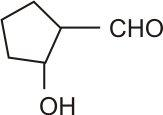
Write the structures of the following compounds.
(i) $\alpha$$\text{-Methylpropionaldehyde}$
(ii) $\text{3-Hydroxybutanal}$
(iii) $\text{2-Hydroxycyclopentane carbaldehyde}$
(iv) $\text{4-Oxopentanal}$
(v) $\text{Di-sec. butyl ketone}$
(vi) $\text{4-Fluoroacetophenone}$
Answer
558.3k+ views
Hint:
Observe all the following compounds and try to figure out the relation between them just like the
$\alpha$ carbon atom is the neighbor carbon atom to the carbonyl carbon atom.
Complete step by step answer:
(i) $\alpha$$\text{-Methylpropionaldehyde:}$

In this compound, the methyl group is connected to the $\alpha$ carbon atom.
The $\alpha$ carbon atom is the neighbour carbon atom to the carbonyl carbon atom.
(ii) $\text{3-Hydroxybutanal:}$

$\text{3-Hydroxybutanal (acetaldol)}$ is actually an aldol, which is formally the result of the dimerization of acetaldehyde. It was formerly used in medicine for the purpose of hypnotic and sedative.
(iii) $\text{2-Hydroxycyclopentane carbaldehyde }$

Molecular weight of 2-Hydroxycyclopentane carbaldehyde is 114.14 g/mol
(iv) 4-Oxopentanal

$\text{4-oxopentanal }$ is a keto-aldehyde which is pentanal replaced by an oxo group at position four. It has a use as a metabolite.
(v) $\text{Di-sec. butyl ketone}$

Replacing the hydroxyl group with a keto group just gives butanone which is the only possible idea for carbon ketone.
Thereby, $\text{di-sec-butyl ketone (3,5-dimethylheptan-4-one)}$ exists.
(vi) $\text{4-Fluoroacetophenone}$

Molecular weight of 4-Fluoroacetophenone is 138.14 g/mol.
Note:
Organic compounds are actually any chemical compounds that have carbon-hydrogen bonds. Because of carbon's capacity to catenate (form chains together with other carbon atoms), more than millions organic compounds are known till date.
Organic compounds, the compounds which are connected with life processes, are the concept matter of organic chemistry. From the many types of organic compounds, 4 major types are found in all living things: carbohydrates, lipids, proteins, and nucleic acids.
Just by concentrating on the following compounds and trying to relate with organic chemistry, it will help further in drawing the structures.
Observe all the following compounds and try to figure out the relation between them just like the
$\alpha$ carbon atom is the neighbor carbon atom to the carbonyl carbon atom.
Complete step by step answer:
(i) $\alpha$$\text{-Methylpropionaldehyde:}$

In this compound, the methyl group is connected to the $\alpha$ carbon atom.
The $\alpha$ carbon atom is the neighbour carbon atom to the carbonyl carbon atom.
(ii) $\text{3-Hydroxybutanal:}$

$\text{3-Hydroxybutanal (acetaldol)}$ is actually an aldol, which is formally the result of the dimerization of acetaldehyde. It was formerly used in medicine for the purpose of hypnotic and sedative.
(iii) $\text{2-Hydroxycyclopentane carbaldehyde }$

Molecular weight of 2-Hydroxycyclopentane carbaldehyde is 114.14 g/mol
(iv) 4-Oxopentanal

$\text{4-oxopentanal }$ is a keto-aldehyde which is pentanal replaced by an oxo group at position four. It has a use as a metabolite.
(v) $\text{Di-sec. butyl ketone}$

Replacing the hydroxyl group with a keto group just gives butanone which is the only possible idea for carbon ketone.
Thereby, $\text{di-sec-butyl ketone (3,5-dimethylheptan-4-one)}$ exists.
(vi) $\text{4-Fluoroacetophenone}$

Molecular weight of 4-Fluoroacetophenone is 138.14 g/mol.
Note:
Organic compounds are actually any chemical compounds that have carbon-hydrogen bonds. Because of carbon's capacity to catenate (form chains together with other carbon atoms), more than millions organic compounds are known till date.
Organic compounds, the compounds which are connected with life processes, are the concept matter of organic chemistry. From the many types of organic compounds, 4 major types are found in all living things: carbohydrates, lipids, proteins, and nucleic acids.
Just by concentrating on the following compounds and trying to relate with organic chemistry, it will help further in drawing the structures.
Recently Updated Pages
Master Class 9 General Knowledge: Engaging Questions & Answers for Success

Master Class 9 English: Engaging Questions & Answers for Success

Master Class 9 Science: Engaging Questions & Answers for Success

Class 9 Question and Answer - Your Ultimate Solutions Guide

Master Class 12 Business Studies: Engaging Questions & Answers for Success

Master Class 12 Economics: Engaging Questions & Answers for Success

Trending doubts
What is meant by exothermic and endothermic reactions class 11 chemistry CBSE

Which animal has three hearts class 11 biology CBSE

10 examples of friction in our daily life

One Metric ton is equal to kg A 10000 B 1000 C 100 class 11 physics CBSE

1 Quintal is equal to a 110 kg b 10 kg c 100kg d 1000 class 11 physics CBSE

Difference Between Prokaryotic Cells and Eukaryotic Cells




